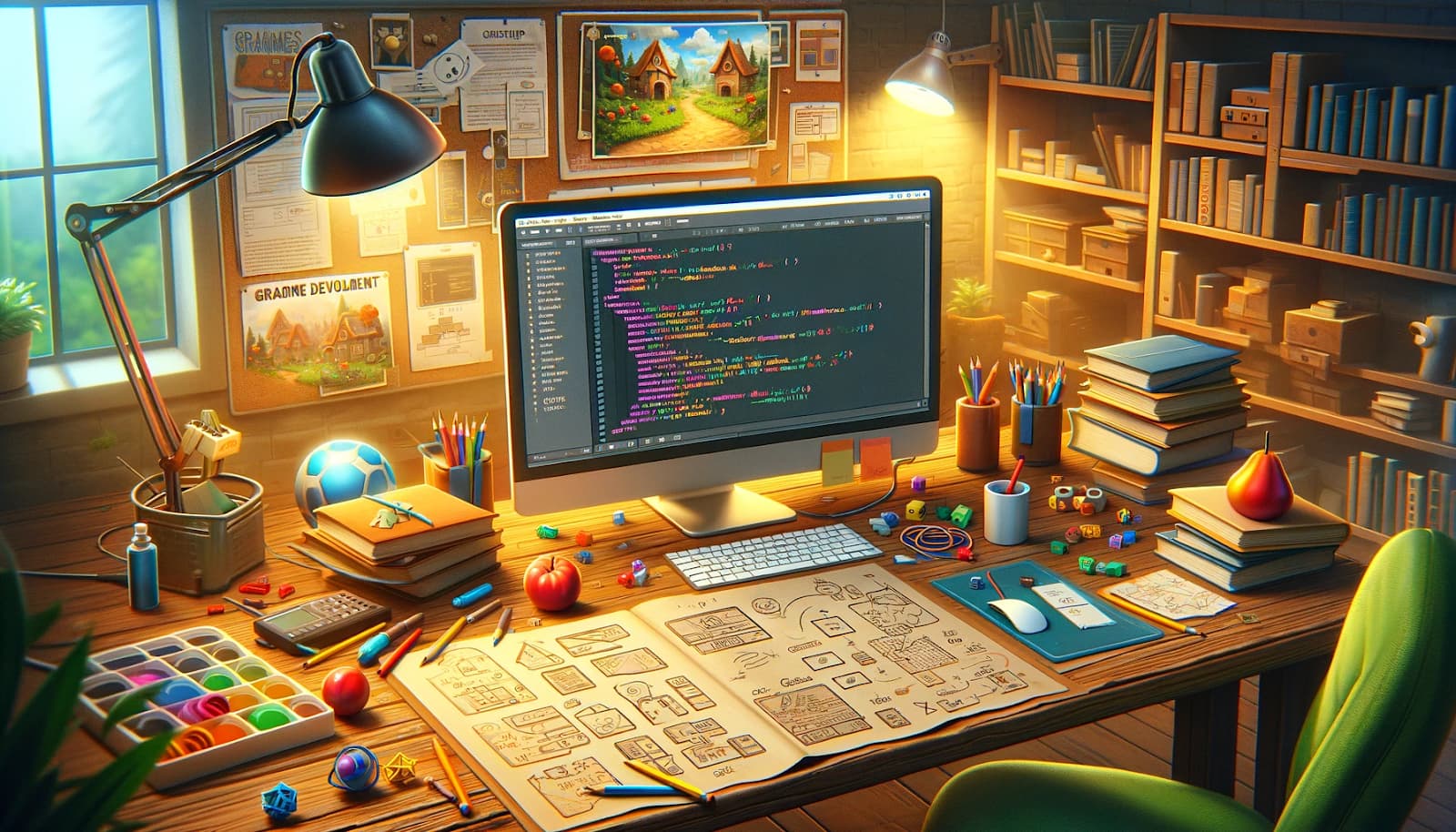Even for novices, making your own web game may be a fun and fulfilling endeavour. This article will walk you through the basic processes of utilising HTML, CSS, and JavaScript to create a straightforward but entertaining browser game.
Step 1: Conceptualize Your Game
The ideation stage, when you establish the framework of your game, is the first and most important step in making a browser game. This entails choosing whether the game will be a strategy game, an action-packed adventure, a puzzle game, or something else new. After selecting a genre, you can start learning about the game mechanics, which are the guidelines and procedures that control how the game is played. This could involve the way in which players engage with the game environment, the difficulties they encounter, and their progression. Furthermore, developing a gripping plot can improve the player’s experience significantly by increasing the game’s immersion and engagement. Simpler games might benefit from a simple tale as well, as it can enhance the gameplay experience. It’s important to specify the game’s main purpose so that players have something to strive for, whether it’s finishing a level, beating a boss, or solving a puzzle. At this point, using paper to draw out the basic arrangement and visual components might help you visualise and improve your ideas. In order to set the scenario for the real development process, this step involves creating the foundation and imagining the entire experience you wish to provide.
Step 2: Set Up Your Development Environment
As it offers the resources and platform required for developing and testing your game, setting up your development environment is an essential first step in making a browser game. First, pick a dependable text editor for writing and organising your code, such Visual Studio Code or Sublime Text. These editors facilitate the writing of error-free code by providing features like code completion and syntax highlighting. After that, in order to test your game, you’ll need a web browser, such as Chrome, Firefox, or Safari. Developer tools included with these browsers are quite helpful for troubleshooting and optimising your game. The most recent versions of HTML, CSS, and JavaScript must also be installed on your computer because they are the fundamental tools you’ll need to make your game. JavaScript adds interactivity and game logic, whereas HTML organises the content of your game and CSS handles display and layout. You can establish a workspace that facilitates the coding, testing, and refinement phases of your game development process by setting up this environment.
Step 3: Learn the Basics of HTML, CSS, and JavaScript
Since HTML, CSS, and JavaScript are the building blocks of online games, it is essential to gain a basic understanding of them before starting the process of developing browser games. The foundational pieces of your game, including text, graphics, and other game components, are created using HTML (HyperText Markup Language), which also serves to layout the general layout of your game’s user interface. Then, to style these elements, CSS (Cascading Style Sheets) is used. With CSS, you can apply creative designs, change layouts, and add colours to make your game visually appealing. JavaScript, the most dynamic component, is what makes your game come to life. It governs the game’s mechanics, processes player inputs, adds interactivity, and handles game logic. Your game would not work and move without JavaScript. Fortunately, there are lots of online tools available to assist novices in learning these languages, such as interactive coding platforms, video courses, and tutorials. These resources are great for people who are new to web development because they typically begin with simpler topics and work their way up to more complicated ones. Gaining proficiency in these languages not only provides a solid basis for game production, but it also expands the creative and functional possibilities for games.
Step 4: Create the Game Structure with HTML
Building a browser game’s structural base with HTML is the first step in the fourth development cycle. The first step in this process is to put up an HTML5 element called a “canvas,” which serves as a dynamic space on the page where the images for your game are drawn. For all intents and purposes, the canvas represents your game’s visuals, animations, and interactive features. Links to your CSS and JavaScript files should also be included in your HTML file. All of the game’s aesthetic components, such as layout, colour scheme, and typeface selection, are styled by the CSS file. You’ll develop the code for your game’s functionality and interactivity in the JavaScript file in the interim. Your game’s fundamental structure is formed by this arrangement, in which HTML provides the environment and space, CSS adds style and design, and JavaScript handles the interactive and dynamic parts. This step involves outlining the essential components that will come together to make your game idea a reality on the internet.
Step 5: Style Your Game with CSS
Utilising CSS (Cascading Style Sheets), you may improve the visual appeal and style of your game in the fifth step of developing a browser game. The aesthetic elements of your game, such as the background, which establishes the mood and ambiance, the font styles, which can be changed to fit the theme, and the appearance of game sprites—visual representations of characters, objects, and other elements—are all crucially defined by CSS. CSS is used to manage the size, location, and even movements of these sprites, which can be static or animated. Furthermore, CSS provides strong layout capabilities like Flexbox and CSS Grid, which are essential for effectively aligning and arranging game objects on the screen. Flexbox gives a one-dimensional layout technique that is perfect for aligning objects in a row or column, whereas CSS Grid offers a two-dimensional grid-based layout approach that allows accurate placement of elements. By utilising these CSS elements, you may produce a visually appealing and captivating gaming environment, guaranteeing that players will find the game to be both immersive and functional in addition to being functional. In this step, the basic HTML structure will be transformed into an eye-catching game that draws in and holds the attention of players.
Step 5: Style Your Game with CSS
Here’s where CSS comes into play to give your browser game some flair and visual appeal. It entails arranging the graphic components that specify how your game will look. To create the ideal mood and theme for the game, you can design the background using CSS. Font styles are picked to enhance the mood of the game and to make text elements understandable and clear, such as instructions and scores. The styling of game sprites — important visual components that serve as visual representations of characters, objects, or obstacles in the game — also requires CSS. CSS provides powerful techniques like CSS Grid and Flexbox to efficiently position and align these visual components. While Flexbox works better for simpler, one-dimensional layouts that are suitable for linear arrangements, CSS Grid is best for generating intricate, two-dimensional layouts that allow for accurate element placement. at order to improve the game experience, the fundamental HTML structure must be transformed into a logical and visually appealing interface at this step.
Step 6: Add Interactivity with JavaScript
JavaScript is the engine behind your browser game, adding dynamic elements and interactivity to the gameplay. It is employed in the writing of the game logic, which establishes the way the game reacts to player input. With JavaScript, you can process user inputs like keystrokes and clicks, animate game objects, and control various game states including beginning, pausing, and finishing the game. You can programme the movement of objects, detect collisions, and keep score by starting with simpler programmes. These scripts can be made more complicated to include more sophisticated game mechanics and features as you get more proficient and familiar with them. This is a critical stage in creating an engaging and playable game that is visually beautiful as well.
Step 7: Testing and Debugging
Debugging and testing are essential steps in the creation of video games. Testing frequently across a range of web browsers guarantees that your game runs smoothly and reliably on multiple platforms while pointing out any compatibility problems. The browser tools that come with Chrome, Firefox, and other browsers make debugging easier. They let you examine code, track performance, and identify mistakes. This procedure is necessary to find and fix problems that can interfere with gameplay and give players a smooth and entertaining experience. This process involves fine-tuning and polishing your game to get rid of issues and improve gameplay.
Step 8: Deployment and Sharing
When your game is polished and completed to your satisfaction, it’s time to release it and play it with others. Free services like GitHub Pages and Netlify, which offer user-friendly interfaces for uploading and managing online content, are suitable for hosting your game. Distributing the URL to your game to friends and relatives can be done via social media, gaming forums, or direct communication. This gives others a chance to appreciate your work and gives you the chance to get feedback, which can be very helpful for future enhancements. This stage signifies the change from development to release, opening up the possibility of your game being seen and played by others.
Step 9: Continuous Learning and Improvement
Ongoing learning and development is the last phase in the creation of web games. The game development industry is always changing, with new tools, methods, and design principles appearing on a regular basis. To advance as a game producer, you must keep up with these advances, try out new concepts, and take user feedback into consideration. Participating in online communities and forums offers chances to network with colleagues, exchange stories, and acquire knowledge. This level is about accepting the dynamic nature of game development, improving your game over time, and constantly refining your talents.


